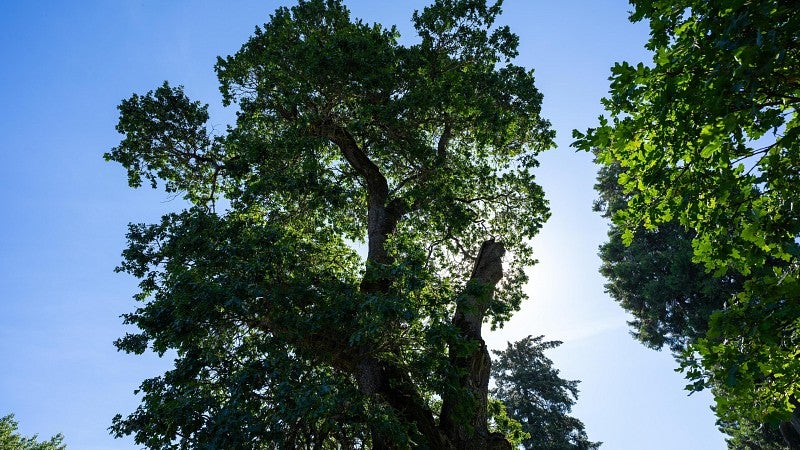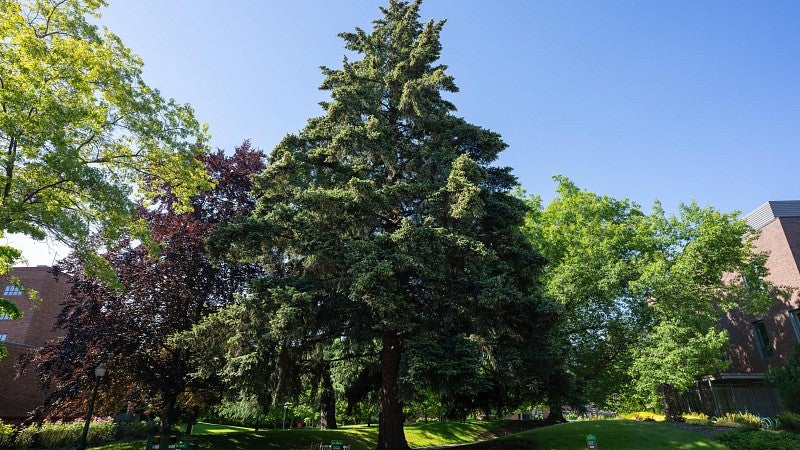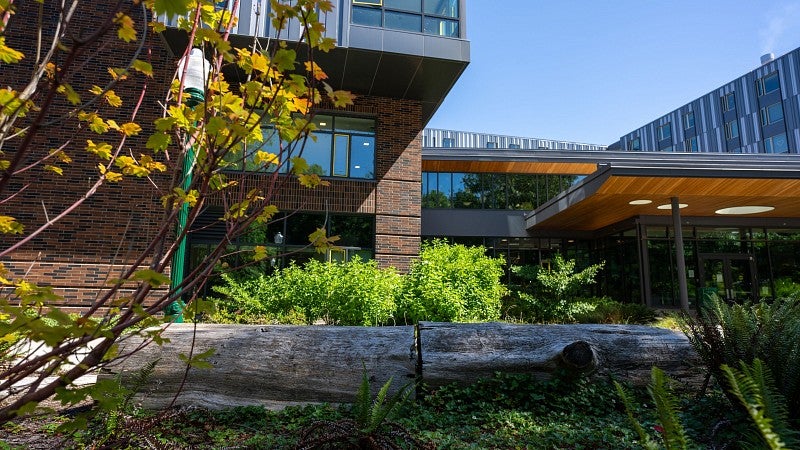Campus in Tree Dimensions: Northwest Natives
The oldest trees on the Eugene campus represent species native to our region
By Jason Stone • Photos by Dustin Whitaker • July 3, 2024
Main story • Distinguished Transplants • Cherished Gifts and Memorials
In the early days, landscaping involved collecting nearby specimens and replanting them on university grounds. Hence, the oldest trees on the Eugene campus represent species native to our region. These trees also were familiar to the Indigenous people of the Willamette Valley. In this section, tree names are provided in English, Latin, and Chinuk Wawa—the pidgin trade language historically shared amongst the diverse tribes of the Pacific Northwest and still spoken by the Confederated Tribes of Grand Ronde.
Oregon White Oak | k’anawi-stik
Quercus garryana

At the time of the university’s founding in 1876, the eighteen-acre campus had been entirely deforested except for two trees that became known as the Condon Oaks. Both were most likely older than the state itself, and one still overlooks the intersection of East Eleventh Avenue and Franklin Boulevard. (Sadly, its companion succumbed to poor health in 2004.) The valley’s Native peoples managed slow-growing white oaks for acorns—one of their staple foods—prior to the arrival of European settlers.
Big Leaf Maple | uskan-stik
Acer macrophyllum

Student volunteers launched the first attempt at expanding the tree inventory on the Eugene campus in 1883, but none of the specimens they transplanted proved viable. The following year, the university janitor facilitated a more successful effort: he was paid a dollar for every seedling that he planted and a bonus dollar for each that survived. Today the big leaf maple outside University Hall—standing sixty feet and richly festooned with mosses and ferns—is believed to be the last living “Dollar Tree.”
Douglas Fir | lakum-stik
Pseudotsuga menziesii

The world’s second-tallest tree species, the Douglas fir is an economic cornerstone and quintessential symbol of the Pacific Northwest. Adorning license plates since 1988, Oregon’s state tree is also a common feature of the Eugene campus. A mature stand lines the University Walk west of University Hall, at one time the school’s main entrance. The famous “Moon Tree” on Thirteenth Avenue is also a Douglas fir, grown from a seed that Apollo XIV astronaut Stuart Roosa carried into the moon’s orbit in 1971. Without a doubt, the most well-travelled tree on campus!
Sitka Spruce | pʰlum-stik
Picea sitchensis

A denizen of foggy coastal regions, the Sitka spruce has roots that furnished basketry materials for indigenous people. Its light, resonant wood also proved ideal for building musical instruments and pre-World War II aircraft. Sections of spruce trunk installed in the landscape outside DeNorval Unthank Jr. Hall came from a tree that stood for more than a century on the Collier House grounds. Felled in 2023 due to disease, these nurse logs cycle the tree’s nutrients back into the local ecosystem to nurture a new generation of native fungi and plants.
Main story • Distinguished Transplants • Cherished Gifts and Memorials
Take a Campus Tree Tour! When you’re in Eugene, we invite you to explore the trees that make the University of Oregon special.
Jason Stone is the strategic communications and writing specialist with University Communications.
Dusty Whitaker is a videographer/photographer with University Communications.

